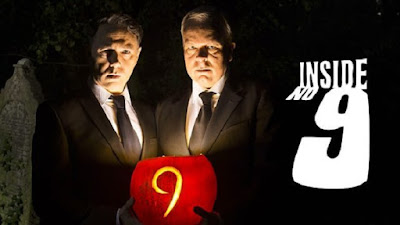The 25th edition of INSIDE NO. 9 was a bold meta-live special that literally explored ghosts in the machine.
REECE Shearsmith and Steve Pemberton's deliciously dark comedy/drama strand INSIDE NO. 9 aired a live Halloween special this year (albeit at 10pm on Sunday October 28th) which was dubbed "GHOSTWATCH for the Twitter generation." Conventionally starting with Arthur Flitwick (Pemberton) finding an old mobile phone in a churchyard, a gullible 20% of the viewing audience gave up after faux sound issues, an error card, then eventual cancellation, which lead to a repeat instead of the programme's series one physical comedy standout A QUIET NIGHT IN. All part of the plan, obviously, as we cut back to Shearsmith and Pemberton in their dressing room, cursing the technical issues that had forced them off air. The meat on the bones is that DEAD LINE is being made at Granada Studios, infamous for paranormal activity due to its location on a Victorian mass grave, and the dead just want to be left alone.
The actual broadcasting mishaps at Granada are fascinating, and archive clips bleed into the stuffed narrative: MOST HAUNTED's CORONATION STREET special, news footage (introduced by Tony Wilson, no less) of the fire that destroyed THE JEWEL IN THE CROWN's costume department, and - best of all - Bobby Davro's trousers-around-his-ankles pillory accident on PUBLIC ENEMY NUMBER ONE (as Lionel Blair, Keith Chegwin and Jim Bowen sing 'Always Look on the Bright Side of Life'); also included is the preview interview clip from THE ONE SHOW, where Shearsmith says that he likes the idea of ghosts, but admits his non-belief. DEAD LINE goes further than the GHOSTWATCH "live" event, as people replied to Shearsmith's on-set Tweets ("Are me and Steve Pemberton on BBC Two now?") and co-star Stephanie Cole's Wikipedia page was altered to reflect her demonic on-screen throat-slitting suicide. The later creepy passages are well staged (one making good use of Shearmith's Reverend Neil's fake head), and the production should be applauded for bringing imagination and playfulness into our media-overloaded existence.
BBC Two Announcer Becky Wright's staged tone lets the cat out of the bag.
Setting productions within a single space or location is a recurring theme for Shearsmith and Pemberton, going right back to their industry foothold in Royston Vasey. The ROPE-inspired episode of PSYCHOVILLE - once intended as a live episode - is a more direct forbear to the self-contained placements of INSIDE NO. 9, which has included a country mansion wardrobe in SARDINES, a sleeper car for LA COUCHETTE and EMPTY ORCHESTRA's karaoke booth. Yet despite this notion these two seasoned writer/performers have shown that their rigorous, twisted style always has respect to the television anthology medium; and when they chart further into their beloved horror genre, it is never with parody (if the terror is present and correct, the comedy will act as a necessary release).
This singular domain for horror or psychological drama taps into the very essence of the Old Dark House sub-genre, buildings beyond architecture that are characters themselves, inhabited by secrets and spectres. Notable examples are stoic in their representation of brooding evil: the Bates Motel, the Overlook Hotel, the Marsten House, 112 Ocean Avenue, the Dakota et al; in fact, some dwellings are not just homes, the House of Usher is also a corrupt dynasty, and in the original draft of Dracula, Bram Stoker had The Count's castle spontaneously fall when staked.































